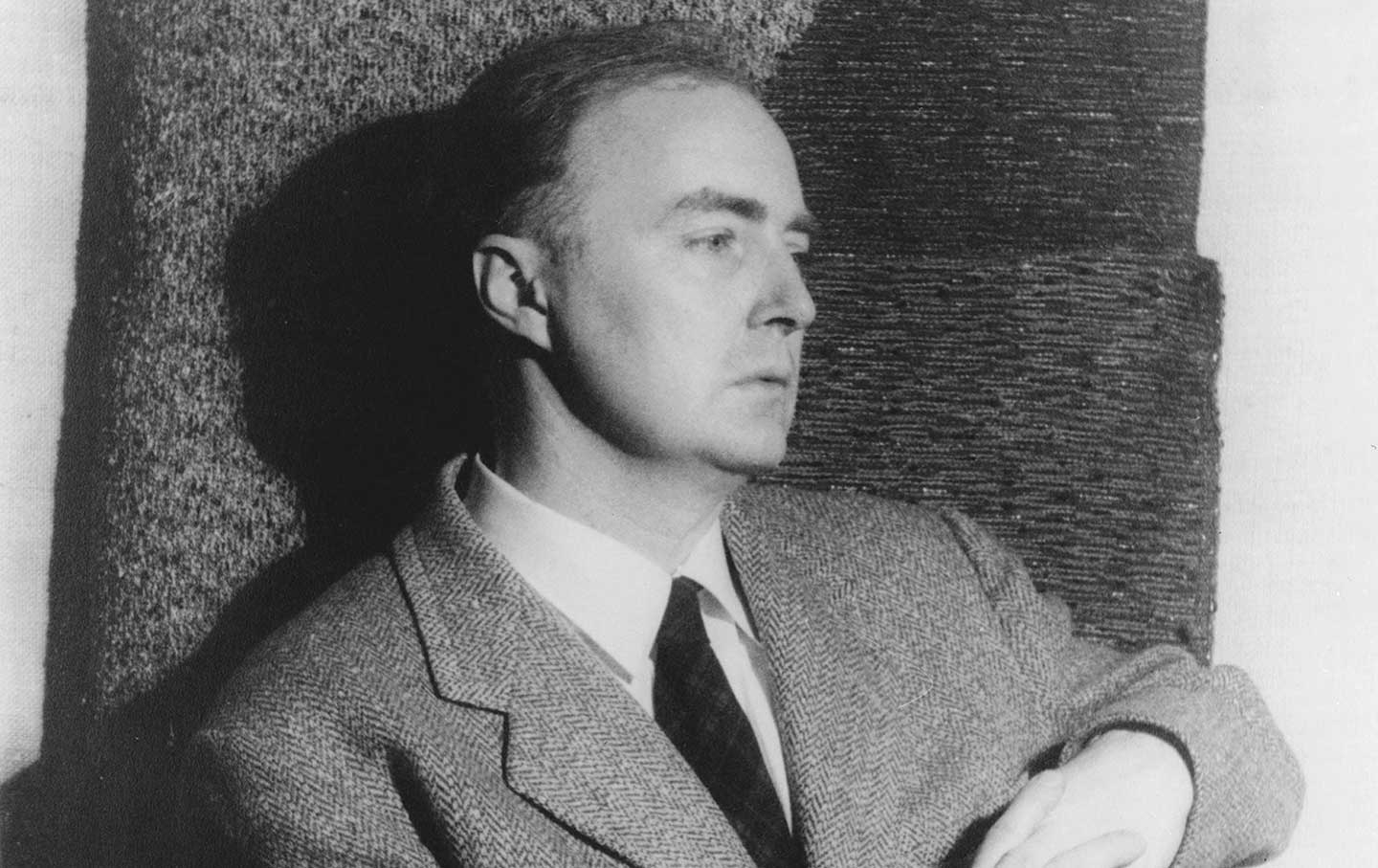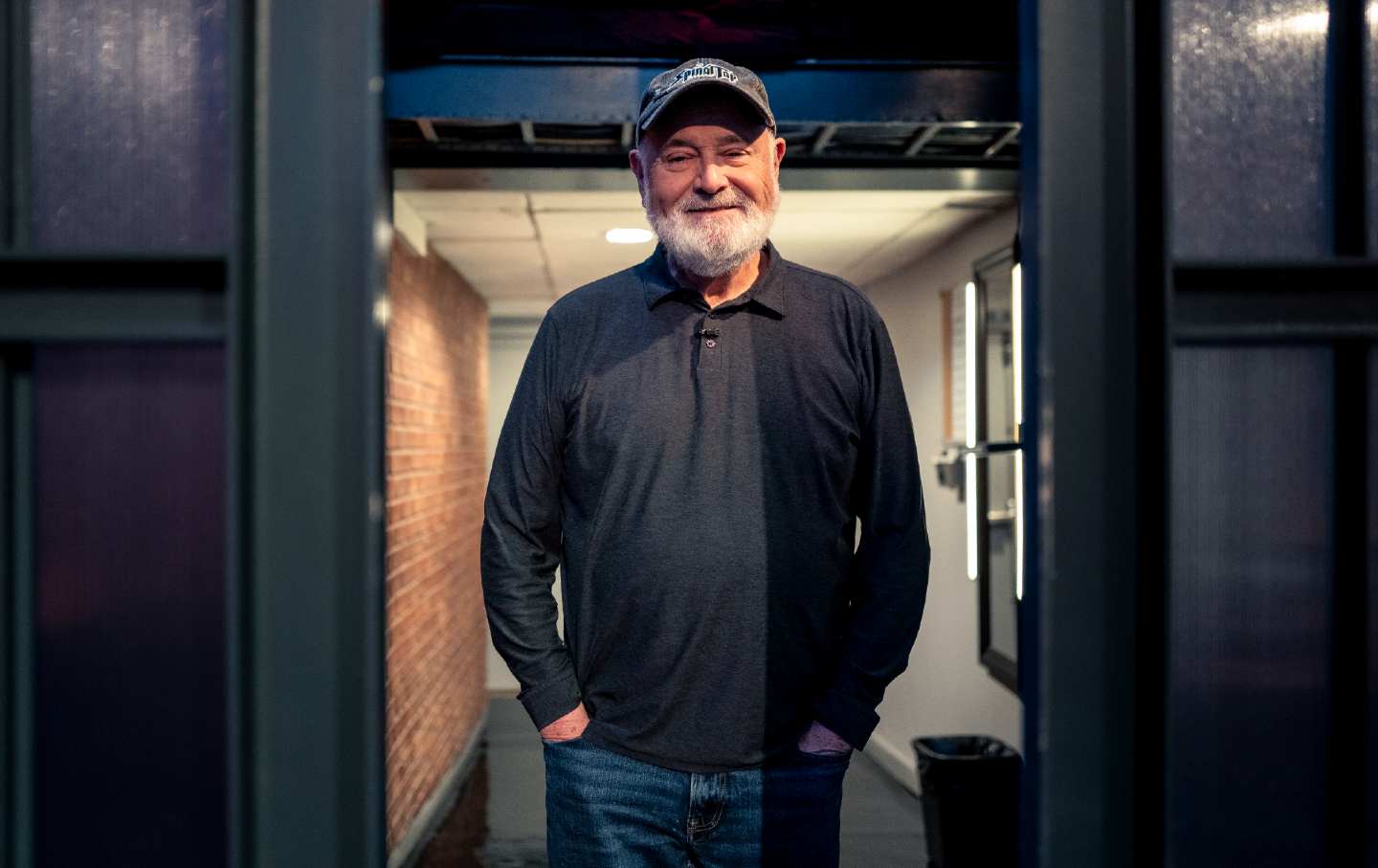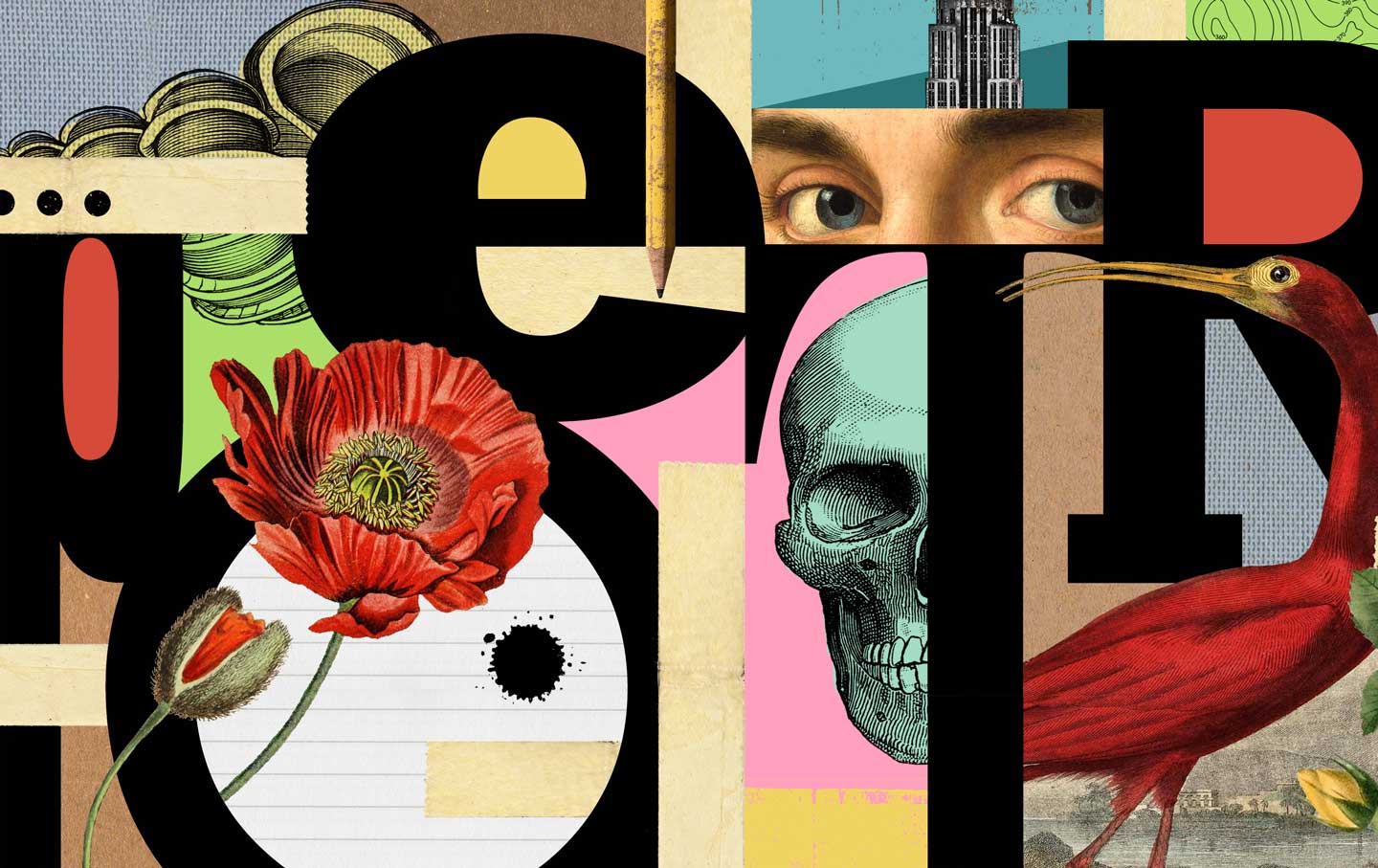The Misfit
James Purdy’s outsider fiction.
James Purdy’s Chronicles of Outsiderdom
His fiction, which ranged from slapstick humor to sheer terror, fixated on the lives of those society discarded.

James Purdy, 1957.
(Photo by Carl Van Vechten Collection / Getty Images)Brawith is a soldier, or at least he was. His grandmother, Moira, has just brought him home from the “Vets Hospital” to her “nice property” in Flempton, a fictional small town in the Midwest. Moira lives in a manor house in a neighborhood where the neighbors know each other’s business. But Brawith, a veteran of an unknown war in an unnamed era, doesn’t ever leave the house or talk much. Instead, he quietly walks around with a toilet paper roll, desperately and ineffectually trying to stanch the very real wounds that doctors say were created “from bullets or an explosion or from both factors.”
Books in review
James Purdy: Life of a Contrarian Writer
Buy this bookPoor, well-intentioned Moira realizes that her grandson is not long for this world, and soon we are told of his slow, inexorable death in gruesome detail:
He was slowly oozing from almost every pore in his body…his attention was entirely occupied by the soft sounds like whispers arising from the wet parts of his insides, which shattered by wounds and hurts had begun gently coming out from within him.
This harrowing demise is the sum and total of Purdy’s 1994 short story, simply titled “Brawith.” A grandmother attempts to help her traumatized, orphaned grandson and instead watches him literally dissolve in the most horrible way imaginable. Brawith’s death is made all the more disturbing by Purdy’s stylistic peculiarities: the long, pebbly sentences and seemingly orderly prose documenting such naked agony. Related to us through Moira’s eyes, the story is as much about the helplessness we experience in the face of life’s cruelty as it is about the cruelty itself.
Published in The Antioch Review, the story was one of the last that appeared during Purdy’s lifetime. He was 79 years old and living in a somewhat self-willed exile from mainstream publishing. When his career began, Purdy’s dry humor and surrealist style made him a veritable literary celebrity. His work was praised to the skies; he was showered with grants and fellowships and supported by the country’s most prestigious editors and publishing houses. But as he got older, his subject matter grew darker, his prose more baroque, and even his funniest work became suffused with anguish. Eventually, his eccentricity curdled into eyebrow-raising prejudice and personal jealousies, while his writing grew more ruthless and strange. As a new biography by Michael Snyder reveals, Purdy was always a bone-deep loner, a man whose idiosyncratic and jaundiced way of seeing and writing about the world grew out of a troubled childhood in a disappearing Midwestern social milieu; a difficult coming-of-age as a gay man in the pre-Stonewall era; and a long, forlorn tenure teaching at a small college in Wisconsin, an expatriate from big-city life. Yet somehow, as Snyder shows, Purdy turned this isolation into literature that embodied the absurdity of the human experience, from terror to slapstick humor, bitter disappointment to magical reverie. Along his winding path of ups and downs, he penned some of the most unforgettable chronicles of outsiderdom in 20th-century US literature.
Born in 1914, Purdy grew up in Defiance County, Ohio, a locale (and name) that could have come from his fiction. He was raised by business-minded Protestant parents whose family wealth disappeared suddenly in his adolescence. Though he wasn’t at all unloved or overly preached-at, he clearly reveled in leaving this small-town world behind him for 1930s Chicago, where he moved after attending college. There he became close friends with a number of artists, including the writer Wendell Wilcox and the bohemian socialite Gertrude Abercrombie, a painter and key supporter of jazz musicians like Charlie Parker. Purdy was writing by then, composing the stories that would eventually make his name, but he was also basking in the first metropolitan scenes he’d ever known. Throughout his career, his focus would fluctuate between the town and the city: His first two books, 63: Dream Palace and Malcolm, were nocturnal urban fantasies, while his third, The Nephew, ended up as a small-town tale.
Once the United States’ entry into World War II seemed inevitable, Purdy enlisted in 1941 to secure a more agreeable assignment than the draft would offer. He was lucky enough to complete his term of service within weeks of Pearl Harbor. “A most unlikely soldier” is how he described himself. During the war, Purdy also found time to travel through Mexico as an interpreter for the painter Norman MacLeish (and also, presumably, as his sexual partner; Snyder speculates that MacLeish was a “sugar daddy”), with whom he’d socialize at Abercrombie’s prewar salons.
In 1944, prior to the war’s end, Purdy returned to Chicago. He befriended Carl Van Vechten, the famous portraitist of Harlem Renaissance figures, who was more than 30 years his senior. Van Vechten became an ally and supporter of Purdy and introduced him to his sprawling social circle, touting the writer’s still-unpublished work.
Purdy’s attendance at Abercrombie’s salons before the war had introduced him to bebop musicians, experimental painters, and literary critics, and now Van Vechten put him in regular contact with figures like Langston Hughes. Despite all of these influential contacts, however, Purdy’s stories still met with steadfast editorial rejection for years. In 1946, he left Chicago to teach Spanish at Lawrence College in Wisconsin and stayed in the position for nearly a decade, an exile from his chosen city and chosen profession. By the mid-1950s, he’d been writing fiction for half his life and had published only a few stories, so he took an amazing gamble, self-publishing a short story collection, Don’t Call Me by My Right Name, and a novella, 63: Dream Palace, and then mailing them to literary tastemakers.
Van Vechten pushed these works on anyone he could, but it was the English novelist Edith Sitwell who finally helped Purdy break through. She read some of his unsolicited offerings and in 1956 all but demanded that her British publisher, Victor Gollancz, buy the rights to both books. This prompted a stateside bidding war that was won by New Directions, which published the two works together under the title Color of Darkness.
Written in a semi-surrealistic tone that blurs any distinction between eerie terror and deadpan humor, 63: Dream Palace is set in Depression-era Chicago. Its protagonist, Parkhearst Cratty, walks around the city like a ghost (“His marriage pursued him like a never-ending nightmare”). Cratty then meets a young West Virginia boy named Fenton Riddleway, who lives with his brother in the last (barely) functioning home on an otherwise destroyed block, and soon the three become enmeshed in a self-destructive knot of interpersonal jealousy. The novella ends in a spasm of violence, the inevitable outcome of repressed emotions in Purdy’s work. Although 63: Dream Palace begins in straightforward fashion, what follows is entirely strange and surprising: romantic (if not exactly sexual) obsession; dialogue-heavy prose with bursts of beautiful but disorientingly rendered physical description; grief-destroyed people forced into fateful collision. The rest of the stories in Color of Darkness are brief, dialogue-driven scenes of emotional confusion between close relations, funnier and less frightening than 63: Dream Palace but still alert to the difficult realities of Chicago life: racism, domestic violence, and class strife.
For the rest of Purdy’s career, these elements—unearthly city- and townscapes merging with grief and uncertainty—would recur over and over again, sometimes with comedic effect, sometimes with a sense of sheer dread, and often in physically revolting or even sadomasochistic scenes. The hero of Purdy’s novel In a Shallow Grave, for example, returns from Vietnam to his hometown on the Virginia coast and pines for an old crush. The trouble is, he has been literally inverted by his service: His veins are now on the outside of his body—a supernatural depiction of PTSD much like that in “Brawith.” Throughout Purdy’s work, the brutality and sadness are so blunt that it’s often unclear whether he intends them as metaphors, dry gallows humor, biblical homages, or some warped and shifting combination of all three. Yet no matter how repetitive his subject matter, Purdy refuses to give his reader a steady footing: Tonal changes, sudden violence, or dark humor can strike at any time, often in the same scene. We are left feeling as adrift as his protagonists.
Purdy was past 40 when the literary world started to take notice of him in the wake of Color of Darkness. Snyder notes that Purdy was a self-conscious late bloomer, a gay man who rejected the idea that he was a “gay writer” and who stood outside of any real “generation.” He routinely claimed to be nine years younger than he was. From Snyder’s telling, he barely read any of his peers; one of his primary influences was his fellow Ohioan Sherwood Anderson, another chronicler of solitary suffering. Even in the era of Jack Kerouac’s amphetamine-fueled ecstaticism, J.D. Salinger’s primly eccentric New Yorker stories, and debuts like Joseph Heller’s Catch-22, Ken Kesey’s One Flew Over the Cuckoo’s Nest, and Thomas Pynchon’s V., Purdy’s prose remained distinctive—mordant, old-fashioned in its grammar, yet also more shocking and transgressive than the output of any of these writers. After the success of Color of Darkness, Purdy was approached by Roger Giroux, who published his first novel, Malcolm—the picaresque tale of a young orphan navigating a cartoonish demimonde of jazz musicians, socialites, and magnates, nearly all of whom make sexual advances that he remains seemingly unaware of—to acclaim. Soon Purdy found his work being praised by the likes of Paul Bowles, Italo Calvino, and Virgil Thompson.
In his 1961 follow-up, The Nephew, Purdy continued to explore the return of the repressed. In fact, the novel’s title character, Cliff Mason, isn’t even alive. The plot concerns his aunt Alama’s attempt to pay tribute to the fallen boy, another vaporized war victim, by interviewing those who knew him. But again the rug is pulled: In the course of pursuing this noble project, Alama learns that her nephew’s life was more complex and largely hidden from her, and she falls into a crisis as she discovers a web of sexual intrigue lurking in the shadows of her small town.
The Nephew is, for critics, among Purdy’s best works, an opinion that Snyder shares. In it, Purdy marries his emotional and aesthetic concerns and uses a series of deadpan two-character dialogues to slowly open up the narrative into a story about people’s intractable psychological distance from one another. Perhaps because he was now working within the center of mainstream publishing, The Nephew is also Purdy’s most straightforward and accessible book, free of the outright fantastic, comic elements of Malcolm or the explicit violence and sex that would come later.
Popular
“swipe left below to view more authors”Swipe →Purdy would rarely write this way again. In his next book, Eustace Chisholm and the Works, he gives us a story about a gay love triangle, set in Chicago during the Depression era, featuring a brutal abortion and culminating in a horrifying torture scene that verges on a passion play. Unlike The Nephew, where the characters gain in complexity as the novel develops, Purdy reduces his characters in Eustace Chisholm to the bare elements of stilted dialogue and desperate emotional urges, creating a near-fable that resists any easy interpretation. The novel was subsequently savaged in The New York Times by Wilfrid Sheed, who called it “a work of black nihilism.”
Purdy was particularly bitter about Sheed’s review, since they shared a publishing house and he interpreted it as a betrayal. Soon he began complaining that his publisher, Farrar, Straus and Giroux, wasn’t paying him enough, a resentment that festered into a belief that the Manhattan literary world had become a closed network of Jewish writers and editors. “I am not an anti-Semite, since I am a Christian,” Purdy wrote to his editor, Robert Giroux, “but my entire neglect is owing in large part to the Jewish propaganda machine which celebrates writers like [Bernard] Malamud and others while hardly admitting I exist.” He claimed that he could no longer trust the publisher to support his work; “he asked Roger Straus to cancel the contract for his next book not long after. Purdy moved to Doubleday in the late 1960s, but after the publisher was unable to secure a New York Times review for his 1974 novel The House of the Solitary Maggot, Purdy felt jilted once again and left mainstream publishing altogether. His next books were brought out by the independent Arbor House. In the decade after his dispute with Roger Straus, Purdy’s fiction became less accessible and more grotesque, but he remained committed to many of his earlier themes. The books ranged from the art-world fantasia I Am Elijah Thrush (recently reissued by Fordham University Press) to the rural tragedies In a Shallow Grave and Narrow Rooms, which features an even more shockingly visceral gay-murder triangle than Eustace Chisholm.
Purdy began to try his hand at other genres, too: He wrote and staged several far-off-Broadway plays and released poetry chapbooks. Although he continued to live in New York and published novel after novel, he remained alienated from the city’s literary scene. In 1998, upon the publication of his 16th novel, Gertrude of Stony Island Avenue, a New York Times review opened with: “Whatever happened to James Purdy? Though his early fiction earned him wide recognition some 40 years ago as an author of major stature, he has been all but absent from the American literary scene for a decade or more.”
There’s an irony here: An author in his mid-80s releases his 16th novel and prompts the nation’s best-known book section to ask why he’s disappeared. Snyder acknowledges that Purdy never played the game of prestige publishing: He never wrote blurbs or reviews, and he never served on a prize committee or taught at a university after escaping Wisconsin. Yet as he aged, Purdy amassed a small coterie of younger gay supporters and assistants who helped organize his archives and kept his refrigerator stocked. He published his stories in small journals, including gay-centered ones, and steadily amassed a capacious body of fiction that never came close to the widespread acclaim of his 1950s and ’60s work but was just as singular. His Completed Short Stories, published by Liveright in 2013 alongside its reissues of Malcolm, Cabot Wright Begins, and Eustace Chisholm and the Works, is a dizzying treasure box of droll scenes, unsettling visions, violent erotica, fairy tales, and haunting portraits.
Although Purdy has been constantly “rediscovered,” he remains a genre of one, his influence more spectral than direct. There’s John Waters, for example, who never misses the chance to praise Purdy in interviews: He’s called Narrow Rooms one of his favorite books (“A salaciously satisfying novel that’s a great read, especially if you’re having a sexual nervous breakdown”) and wrote the introduction to the Completed Short Stories as well. Waters’s films are cheerier and less emotionally fraught than Purdy’s books, but he clearly shares the old master’s predilection for the marginalized and his affinity for shocking, riling, or otherwise rubbing an audience’s face in the filthiest aspects of human behavior.
Purdy also had a life-changing impact on Gordon Lish, whose notorious penchant for pared-down language was partly inspired by Purdy’s early conversational stories and whose editorial influence on the fiction of the 1970s, ’80s, and ’90s was immense. In this way, Raymond Carver, Barry Hannah, Rick Bass, and the other so-called “dirty realists” owe something to Purdy’s earlier innovations, even if they never read him. Nevertheless, it’s hard to imagine those stories or Eustace Chisolm on a syllabus of postwar literature; they remain too nerve-wracking and grotesque to be read alongside Norman Mailer or John Updike, despite the fact that they once were.
Even though Purdy’s reputation has often preceded him, no literary comparisons or name-dropping can prepare one for the mystifying experience of encountering Purdy on the page. Few people wrote more vividly or imaginatively about loneliness and despair, and if that makes him seem dark or daunting, trust that his writing is often cozy and silly, not just scary. The great wonder of it is that you can never tell, from one book to the next or even page to page, which feeling might grip you. Body horror might arrive like a flock of birds, a life-destroying obsession might be summoned by a wish, and all sorts of passions or oracular moments might be found waiting in a jazz loft or at a professor’s house, or heralded by a naked stranger knocking on a door. And when such feelings come, Purdy’s readers must reckon with the possibility that they, too, are as solitary and displaced as any of the author’s beloved misfits.
Disobey authoritarians, support The Nation
Over the past year you’ve read Nation writers like Elie Mystal, Kaveh Akbar, John Nichols, Joan Walsh, Bryce Covert, Dave Zirin, Jeet Heer, Michael T. Klare, Katha Pollitt, Amy Littlefield, Gregg Gonsalves, and Sasha Abramsky take on the Trump family’s corruption, set the record straight about Robert F. Kennedy Jr.’s catastrophic Make America Healthy Again movement, survey the fallout and human cost of the DOGE wrecking ball, anticipate the Supreme Court’s dangerous antidemocratic rulings, and amplify successful tactics of resistance on the streets and in Congress.
We publish these stories because when members of our communities are being abducted, household debt is climbing, and AI data centers are causing water and electricity shortages, we have a duty as journalists to do all we can to inform the public.
In 2026, our aim is to do more than ever before—but we need your support to make that happen.
Through December 31, a generous donor will match all donations up to $75,000. That means that your contribution will be doubled, dollar for dollar. If we hit the full match, we’ll be starting 2026 with $150,000 to invest in the stories that impact real people’s lives—the kinds of stories that billionaire-owned, corporate-backed outlets aren’t covering.
With your support, our team will publish major stories that the president and his allies won’t want you to read. We’ll cover the emerging military-tech industrial complex and matters of war, peace, and surveillance, as well as the affordability crisis, hunger, housing, healthcare, the environment, attacks on reproductive rights, and much more. At the same time, we’ll imagine alternatives to Trumpian rule and uplift efforts to create a better world, here and now.
While your gift has twice the impact, I’m asking you to support The Nation with a donation today. You’ll empower the journalists, editors, and fact-checkers best equipped to hold this authoritarian administration to account.
I hope you won’t miss this moment—donate to The Nation today.
Onward,
Katrina vanden Heuvel
Editor and publisher, The Nation
More from The Nation

Rob Reiner’s Legacy Can't Be Sullied by Trump’s Shameful Attacks Rob Reiner’s Legacy Can't Be Sullied by Trump’s Shameful Attacks
The late actor and director leaves behind a roster of classic films—and a much safer and juster California.

Helen DeWitt and Ilya Gridneff’s Sweeping Anti-War Novel Helen DeWitt and Ilya Gridneff’s Sweeping Anti-War Novel
Your Name Here dramatizes the tensions and possibilities of political art.
Solution to the “Big Event” Crossword Solution to the “Big Event” Crossword
If questions remain after reading this, please write to sandy @ thenation.com.

Blood Orange’s Sonic Experiments Blood Orange’s Sonic Experiments
Dev Hynes moves between grief and joy in Essex Honey, his most personal album yet.




